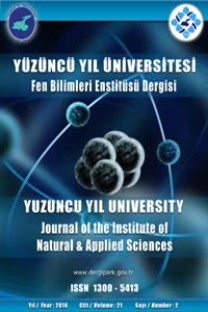Bakteriyel Konsantrasyonu Ölçmek için Excel Tabanlı Bir Hesap Makinası
Bakteriyel hesaplama, Kalibrasyon Eğrisi, McFarland hesap makinası, McFarland standardları
An Excel-based Calculator for Measuring Bacterial Concentration
___
- Almeida, A. M., Castel-Branco, M. M., & Falcão, A. C. (2002). Linear regression for calibration lines revisited: Weighting schemes for bio analytical methods. Journal of Chromatography. B., 774(2), 215–222. doi:10.1016/S1570-0232(02)00244-1
- Bressolle, F., Bromet-Petit, M., & Audran, M. (1996). Validation of liquid chromatographic and gas chromatographic methods. Applications to pharmacokinetics. Journal of Chromatography B: Biomedical Sciences and Applications. 686(1), 3–10. doi:10.1016/S0378-4347(96)00088-6
- Cuadros-Rodríguez, L., García-Campaña, A. M., & Bosque-Sendra, J. M. (1996). Statistical estimation of linear calibration range. Analytical Letters, 29(7), 1231-1239. doi:10.1080/00032719608001471
- Edwards, A. (2019). How to do a linear calibration curve in excel. https://www.howtogeek.com/399883/how-to-do-a-linear-calibration-curve-in-excel/ Last accessed on 20.06.2020.
- Escher, B. I., Neale, P. A., & Villeneuve, D. L. (2018). The advantages of linear concentration–response curves for in vitro bioassays with environmental samples. Environmental Toxicology and Chemistry, 37(9), 2273-2280. doi:10.1002/etc.4178
- Farhat, N., Hammes, F., Prest, E., & Vrouwenvelder, J. (2018). A uniform bacterial growth potential assay for different water types. Water Research, 142, 227-235. doi:10.1016/j.watres.2018.06.010
- Gu, H., Liu, G., Wang, J., Aubry, A. F., & Arnold, M. E. (2014). Selecting the correct weighting factors for linear and quadratic calibration curves with least-squares regression algorithm in bio analytical LC-MS/MS assays and impacts of using incorrect weighting factors on curve stability, data quality, and assay performance. Analytical Chemistry, 86(18), 8959–8966. doi:10.1021/ac5018265
- Hayashi, Y., Matsuda, R., Ito, K., Nishimura, W., Imai, K., & Maeda, M. (2005). Detection limit estimated from slope of calibration curve: an application to competitive ELISA. Analytical Sciences, 21(2), 167-169. doi:10.2116/analsci.21.167
- Isenberg, H. D. (2004). McFarland Standards. Clinical Microbiology Procedures Handbook, vol 2. DC, USA: ASM Press.
- McFarland, J. (1907). The Nephelometer: An instrument for estimating the number of bacteria in suspensions used for calculating the opsonic index and for vaccines. Journal of the American Medical Association, 49(14), 1176–1178. doi:10.1001/jama.1907.25320140022001f
- Moosavi, S. M., & Ghassabian, S. (2018). Linearity of Calibration Curves for Analytical Methods: A Review of Criteria for Assessment of Method Reliability. In M. T. Stauffer (Ed.), Calibration and Validation of Analytical Methods - A Sampling of Current Approaches. IntechOpen. https://doi.org/10.5772/intechopen.72932
- Pesti, G. M., Billard, L., Wu, S. B., Swick, R. A., Nguyen, T. T. H., & Morgan, N. (2022). Abductive statistical methods improve the results of calibration curve bioassays: An example of determining zinc bioavailability in broiler chickens. Animal Nutrition, 10, 294-304. doi:10.1016/j.aninu.2022.04.008
- Prichard, L., & Barwick, V. (2003). Preparation of Calibration Curves: A Guide to Best Practice. Teddington, UK: VAM. doi:10.13140/RG.2.2.36338.76488
- Sofalvi, S., & Schueler, H. E. (2021). Assessment of bioanalytical method validation data utilizing heteroscedastic seven-point linear calibration curves by EZSTATSG1 customized microsoft excel template. Journal of Analytical Toxicology, 45(8), 772-779. doi:10.1093/jat/bkab047
- Zapata, A., & Ramirez-Arcos, S. (2015). A comparative study of McFarland turbidity standards and the densimat photometer to determine bacterial cell density. Current Microbiology, 70, 907-909. doi:10.1007/s00284-015-0801-2
- ISSN: 1300-5413
- Yayın Aralığı: 3
- Başlangıç: 1995
- Yayıncı: Van Yüzüncü Yıl Üniversitesi Fen Bilimleri Enstitüsü
Tek Bir Kanaldan Kaotik Maskelenmiş Ses Sinyalinin İletilmesi
Ali Can ÇABUKER, Mehmet Nuri ALMALI, İshak PARLAR
Yeşil Cevizlerden Ultrason Destekli Ekstraksiyon Yöntemiyle Fenolik Bileşiklerin Eldesi
Serdar UĞURLU, Emre BAKKALBAŞI
Kentsel Yeşil Alanların Planlamasında Kullanılan Konumsal Analiz Yöntemleri ve Kullanım Olanakları
Onur ŞATIR, Okan YELER, Serkan KEMEÇ
WHAM Hα Verileri Kullanılarak NGC 7822 (Sh2-171) HII Bölgesinin İncelenmesi
Bakteriyel Konsantrasyonu Ölçmek için Excel Tabanlı Bir Hesap Makinası
Aykut AYDIN, Nazmi POLAT, Semra SAYGIN, Melek ÖZPİÇAK, Savaş YILMAZ
Üç Fazlı Bir Asenkron Motorun Çeşitli Bobin Adım Biçimi ile Performans ve Harmonik Analizi
Akkaraman Koyun Irkında Callipyge Gen Polimorfizmin Araştırılması
